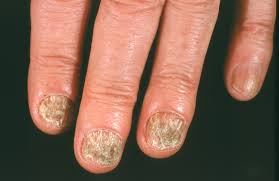
Onychomycosis is also called as fungal nails. Fungus infects the areas between toes and the skin of feet, its called athlete's foot (tinea pedis). It can affect several nails.
Fungal nails
Onychomycosis is also called as fungal nails. Fungus infects the areas between toes and the skin of feet, its called athlete's foot (tinea pedis). It can affect several nails.
Nail fungus is a common condition that begins as a white or yellow spot under the tip of fingernail or toenail. The nails become thicken, discolor and crumble at the edge as the fungal infection goes deeper.
Symptoms:
· Thickened
· Whitish to yellow-brown discoloration
· Brittle, crumbly or ragged
· Distorted in shape
· A dark color, caused by debris building up under your nail
· Smellling slightly foul
Causes:
Risk factors:
· Having a history of athlete's foot
· More years of exposure to fungi
· Being older
· Sweating heavily
· Owing to reduced blood flow
· Having a minor skin or nail injury or a skin condition, such as psoriasis
· Slower growing nails
· Walking barefoot in gyms, swimming pools and shower rooms
· Having a weakened immune system, diabetes or circulation problems
Complications:
Preventions:
· Wash your hands and feet regularly. Wash your hands after touching an infected nail. Moisturize your nails after washing.
· Trim nails straight across, smooth the edges with a file and file down thickened areas.
· Change the socks throughout the day or Wear sweat-absorbing socks.
· Disinfect nail clippers after each use.
· Choose shoes made of materials that breathe.
· Discard old shoes or treat them with disinfectants or antifungal powders.
· Wear footwear in pool areas and locker rooms.
· Choose a nail salon that uses sterilized manicure tools for each customer.
· Give up nail polish and artificial nails.
Diagnosis: Your doctor will examine your nails. He or she may also take some nail clippings or scrape debris from under your nail and send the sample to a lab to identify the type of fungus causing the infection.
Treatment: These type infections can be difficult to treat. The treatment depends on the severity of condition and the type of fungus causing it.
· Your doctor might suggest temporary removal of the nail so that he or she can apply the antifungal drug directly to the infection under the nail.
· Some fungal nail infections don't respond to medicines so permanent nail removal is suggested if the infection is severe or extremely painful.
Fungal nails, onychomycosis, fungus, athlete\'s foot, tinea pedis.